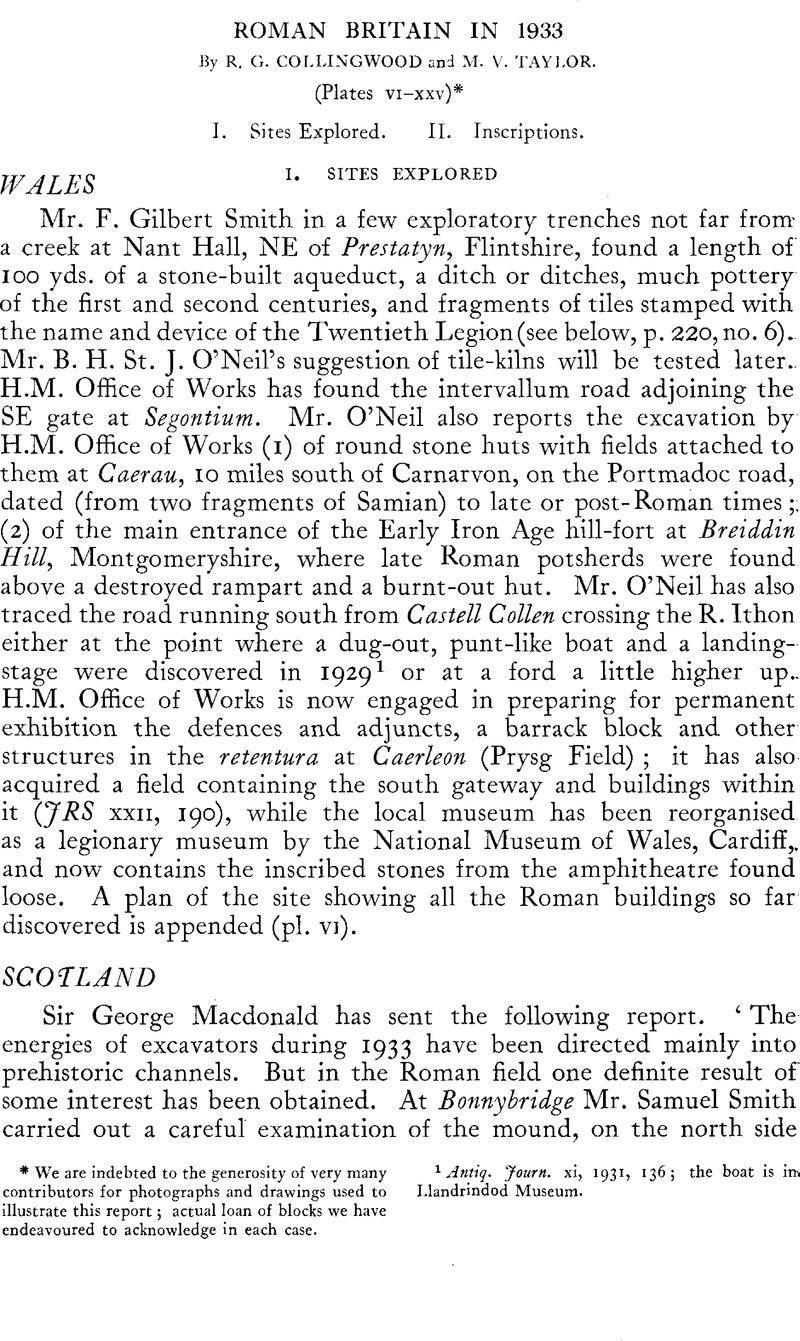Published online by Cambridge University Press: 24 September 2012

* We are indebted to the generosity of very many contributors for photographs and drawings used to illustrate this report; actual loan of blocks we have endeavoured to acknowledge in each case.
1 Antiq. Journ. xi, 1931, 136Google Scholar; the boat is in Llandrindod Museum.
2 Published in Numis. Chron., 1934, p. 1 ff.
3 Prof. Gordon Childe's report is published in PSA Scot lxvii, 385 ff.
4 Arch. Ael. ser. 4, xi, 176–184, with Mr. John Charlton's plan (below, fig. 1).
5 Ibid., pp. 185–193; report on small finds by J. Charlton, pp. 193–205; on Housesteads Milecastle, by P. Hunter-Blair, pp. 103–120.
6 A small relief of three hooded figures in profile is in the Cripps Collection at Cirencester. See also Bruce, Lapid. nos. 492 and 786 for two others from Carlisle and possibly from Netherby, with a reference to a third from Wycomb, near Withington, Gloucs. We are indebted to Mr. Birley for the photographs shown in pl. VII.
7 For these types, see Arch. Ael. ser. 4, viii, 308 f.
8 Excavated in 1907 by Mr. F. G. Simpson.
9 JRS XXIII, 194.
10 Cumb. and Westm. Arch. Soc. Trans. N.s. xxxiv, 110–165.
11 Ibid. xxxi, 144–145.
12 This has now (1934) been Confirmed by finding the Turf-Wall at Dykesfield and a Turf-Wall turret, 79b, at Bowness.
13 op. cit. xiii, 321–22, pl. xiii.
14 cf. JRS XXIII, 193, n. 6.
15 Arch. Aeliana, 4th ser., xi, 1934, 83 ffGoogle Scholar.
16 A report is published in the Yorks. Arch. Journ. xxxi, 366 ff. For information about York shire sites we are indebted to Miss Mary Kitson Clark and Mr. Philip Corder.
17 VCH Hunts, i, 261 f.
18 Admirable report in Cambs. & Hunts. Arch. Soc. Proc. v, 89, 181 ff.
19 Cf. JRS XIV, 228, XIX, 195; Antiquity vi, 359; Oxfordshire Arch. Soc. Reports, 1929, 229. The ironstone workers who discovered and preserved this group are Messrs. Percy Heath and Len Gregory.
20 R. E. M. and T. V. Wheeler, Lydney Report (Soc. Antiq. Research Reports ix, 1932), fig. 17, p. 82; Brown, Baldwin, The Arts of Early England, iv (1915), 458Google Scholar. We are indebted to Mr. W. F. J. Knight for the drawing of the bracelet, to Mr. Christopher Hawkes for arranging the drawings of the British Museum examples made by Mrs. Michell-Clarke, and to Mr. Waddington for details of others in the Guildhall Museum.
21 Now in the Ashmolean Museum, Oxford.
22 Kaye, W. J., Antiquary l (1914), 172, 223, 290Google Scholar; Colchester Museum Report (1910), pl. iii, p. 9; Reliquary N.s. xii (1906), 210Google Scholar, for one found in a grave, hence May, Catal. of Colchester and Essex Museum (1930), p. 145, fig. For early examples and their relation to Kernoi, see Bosanquet BSA Papers iii, 57.
23 Sent by Mr. W. P. Westell of Letchworth Museum. For balances see Daremberg and Saglio Dict, des Antiq. s.v. ‘Libra’ and B.M. Guide to Greek and Roman Life.
24 Norfolk and Norwich Archaeology xxv, 202 ff.
25 Proc. of Prehistoric Soc. of E. Anglia vii, 231 ff.
26 A detailed report by Mr. Hullis to be published as a Research Report of the Society of Antiquaries.
27 Oelmann, , Die Keramik des Kastells Niederbieber, p. 77Google Scholar, Taf. iv, no. 105, and therefore possibly of the late second or early third century.
28 Roman London (R.C.H.M. Inventory), p. 129, fig. 47. The sandal mentioned in no. 3 has been published by Mr. Quinton Waddington in The Antiquaries Journal, xiv, 297 f.
29 For details see Bristol and Gloucs. Arch. Soc. Trans, lv, 1933, 323Google Scholar, to which and to the authors, we are indebted for the plan and the block of pl. XXIII, 3.
30 VCH Somerset i, 294.
31 ibid., p. 29c.
32 A detailed account by MrSeaby, W. A. in Berks. Arch. Journ. xxxviii, 75Google Scholar, to wbich we are indebted for the loan of the block used in fig. 6.
33 cf. Sumner, Rockhourne Down (1914), p. 23, hypocaust no. iii, which contained grains of charred wheat and therefore was probably used for corn drying; sec Haverfield, Roman Britain in 1913, pp. 23–25.
34 See Surrey Arch. Coll. xix, 27; CIL vii, 1244, and cf. Essex Arch. Soc. Trans. i, 1885, 60Google Scholar, and Eph. Ep. iii, p. 142, no. 124, for others from Chelmsford.
35 VCII Kent iii, 125.
36 Ibid., p. 124.
37 Ibid., p. 161.
38 Bruce, Roman Wall, ed. 2, p. 298, records how this mason wrote to the antiquary and novelist R. S. Surtees to inform him of the facts, describing the object as an halter; and how Surtees was provoked to reply, ‘Keep the halter for your own use.’